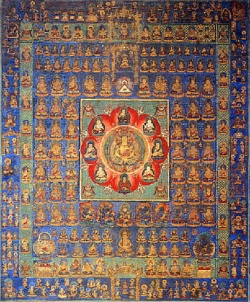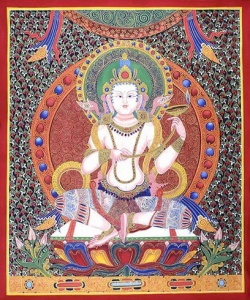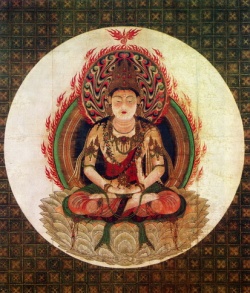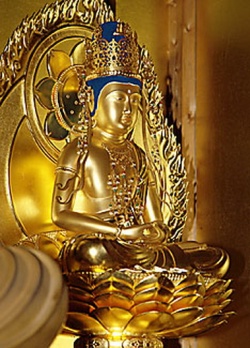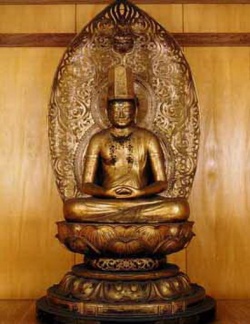Vaisheshika
Vaisheshika or Vaiśeṣika (Sanskrit: वैशेषिक) is one of the six Hindu schools of philosophy (Vedic systems) of India. Historically, it has been closely associated with the Hindu school of logic, Nyaya.
Vaisheshika espouses a form of atomism and postulates that all objects in the physical universe are reducible to a finite number of atoms. Originally proposed by the sage Kaṇāda (or Kana-bhuk, literally, atom-eater) around the 2nd century BC.
Overview
Although the Vaisheshika system developed independently from the Nyaya, the two eventually merged because of their closely related metaphysical theories. In its classical form, however, the Vaishesika school differed from the Nyaya in one crucial respect: where Nyaya accepted four sources of valid knowledge, the Vaishesika accepted only perception and inference. Although not among Kanada's original philosophies, later Vaishesika atomism also differs from the atomic theory of modern science by claiming the functioning of atoms(or their characterization because of which they function in their way) was guided or directed by the will of the Supreme Being or Supreme Concept.
An alternative view would qualify the above in that the holism evident in the ancient texts mandate the identification of six separate traditional environments of philosophy, consisting of three sets of two pairs.
Literature of Vaisheshika
The earliest systematic exposition of the Vaisheshika is found in the Vaiśeṣika Sūtra of Kaṇāda (or Kaṇabhaksha). This treatise is divided into ten books. The two commentaries on the Vaiśeṣika Sūtra, Rāvaṇabhāṣya and Bhāradvājavṛtti are no more extant. Praśastapāda’s Padārthadharmasaṁgraha (c. 4th century) is the next important work of this school. Though commonly known as bhāṣya of Vaiśeṣika Sūtra, this treatise is basically an independent work on the subject. The next Vaisheshika treatise, Candra’s Daśapadārthaśāstra (648) based on Praśastapāda’s treatise is available only in Chinese translation. The earliest commentary available on Praśastapāda’s treatise is Vyomaśiva’s Vyomavatī (8th century). The other three commentaries are Śridhara’s Nyāyakandalī (991), Udayana’s Kiranāvali (10th century) and Śrivatsa’s Līlāvatī (11th century). Śivāditya’s Saptapadārthī which also belongs to the same period, presents the Nyāya and the Vaiśeṣika principles as a part of one whole. Śaṁkara Miśra’s Upaskāra on Vaiśeṣika Sūtra is also an important work.
The Categories or Padārtha
According to the Vaisheshika school, all things which exist, which can be cognised, and which can be named are padārthas (literal meaning: the meaning of a word), the objects of experience. All objects of experience can be classified into six categories, dravya (substance), guṇa (quality), karma (activity), sāmānya (generality), viśeṣa (particularity) and samavāya (inherence). Later Vaiśeṣikas (Śrīdhara and Udayana and Śivāditya) added one more category abhava (non-existence). The first three categories are defined as artha (which can perceived) and they have real objective existence. The last three categories are defined as budhyapekṣam (product of intellectual discrimination) and they are logical categories.
1.Dravya (substance): The substances are conceived as 9 in number. They are, pṛthvī (earth), ap (water), tejas (fire), vāyu (air), ākaśa (ether), kāla (time), dik (space), ātman (self) and manas (mind). The first five are called bhūtas, the substances having some specific qualities so that they could be perceived by one or the other external senses.
2.Guṇa (quality): The Vaiśeṣika Sūtra mentions 17 guṇas (qualities), to which Praśastapāda added another 7. While a substance is capable of existing independently by itself, a guṇa(quality) cannot exist so. The original 17 guṇas (qualities) are, rūpa (colour), rasa (taste), gandha (smell), sparśa (touch), saṁkhyā (number), parimāṇa ([[Wikipedia:size|size]]/dimension/quantity), pṛthaktva (individuality), saṁyoga (conjunction/accompaniments), vibhāga (disjunction), paratva (priority), aparatva (posteriority), buddhi (knowledge), sukha (pleasure), duḥkha (pain), icchā (desire), dveṣa (aversion) and prayatna (effort). To these Praśastapāda added gurutva (heaviness), dravatva (fluidity), sneha (viscosity), dharma (merit), adharma (demerit), śabda (sound) and saṁkāsra (faculty).
3.Karma (activity): The karmas (activities) like guṇas (qualities) have no separate existence, they belong to the substances. But while a quality is a permanent feature of a substance, an activity is a transient one. Ākāśa (ether), kāla (time), dik (space) and ātman (self), though substances, are devoid of karma (activity).
4.Sāmānya (generality): Since there are plurality of substances, there will be relations among them. When a property is found common to many substances, it is called sāmānya.
5.Viśeṣa (particularity): By means of viśeṣa, we are able to perceive substances as different from one another. As the ultimate atoms are innumerable so are the viśeṣas.
6.Samavāya (inherence): Kaṇāda defined samavāya as the relation between the cause and the effect. Praśastapāda defined it as the relationship existing between the substances that are inseparable, standing to one another in the relation of the container and the contained. The relation of samavāya is not perceivable but only inferable from the inseparable connection of the substances.
Epistemology and syllogism
The early Vaiśeṣika epistemology considered only pratyakṣa (perception) and anumāna (inference) as the pramāṇas (means of valid knowledge). The other two means of valid knowledge accepted by the Nyāya school, upamāna (comparison) and śabda (verbal testimony) were considered as included in anumāna. The syllogism of the Vaiśeṣika school was similar to that of the Nyāya, but the names given by Praśastapāda to the 5 members of syllogism are different.
The atomic theory
The early Vaiśeṣika texts presented the following syllogism to prove that all objects i.e. the four bhūtas, pṛthvī (earth), ap (water), tejas (fire) and vāyu (air) are made of indivisible paramāṇus (atoms): Assume that the matter is not made of indivisible atoms, and that it is continuous. Take a stone. One can divide this up into infinitely many pieces (since matter is continuous). Now, the Himalayan mountain range also has infinitely many pieces, so one may build another Himalayan mountain range with the infinite number of pieces that one has. One begins with a stone and ends up with the Himalayas, which is a paradox - so the original assumption that matter is continuous must be wrong, and so all objects must be made up of a finite number of paramāṇus (atoms).
According to the Vaiśeṣika school, the trasareṇu (dust particles visible in the sunbeam coming through a small window hole) are the smallest mahat (perceivable) particles and defined as tryaṇukas (triads). These are made of three parts, each of which are defined as dvyaṇuka (dyad). The dvyaṇukas are conceived as made of two parts, each of which are defined as paramāṇu (atom). The paramāṇus (atoms) are indivisible and eternal, they can neither be created nor destroyed. Each paramāṇu (atom) possesses its own distinct viśeṣa (individuality).
The measure of the partless atoms is known as parimaṇḍala parimāṇa. It is eternal and it cannot generate the measure of any other substance. Its measure is its own absolutely.
Later developments
Over the centuries, the school merged with the Nyaya school of Indian philosophy to form the combined school of nyāya-vaiśeṣika. The school suffered a natural decline in India after the 15th century.
Views by the Vedanta School
The Vaisheshikas say that the visible universe is created from an original stock of atoms (janim asataḥ). As Kaṇāda's Vaiśeṣika Sūtra (7.1.26) states, nityaṃ parimaṇḍalam (that which is of the smallest size, the atom, is eternal), he and his followers also postulate eternality for other, nonatomic entities, including the souls who become embodied, and even a Supreme Soul. But in Vaiśeṣika cosmology the souls and the Supersoul play only token roles in the atomic production of the universe. The Brahma Sutra (2.2.12) says ubhayathāpi na karmatas tad-abhavaḥ. According to this sūtra, one cannot claim that, at the time of creation, atoms first combine together because they are impelled by some karmic impulse adhering in the atoms themselves, since atoms by themselves, in their primeval state before combining into complex objects, have no ethical responsibility that might lead them to acquire pious and sinful reactions. Nor can the initial combination of atoms be explained as a result of the residual karma of the living entities who lie dormant prior to creation, since these reactions are each jiva's own and cannot be transferred from them even to other jīvas, what to speak of inert atoms.
Source
Kanada, a learned sage, founded this system. This system is believed to be as old as Jainism and Buddhism. Kanada presented his detailed atomic theory in Vaisheshika-Sutra. Basically, Vaisheshika is a pluralistic realism. It explains the nature of the world with seven categories:
Dravya (substance), guna (quality), karma(action), samanya(universal), vishesha (particular), amavaya(inherence) and abhava (non-existence).
Vaisheshika contends that every effect is a fresh creation or a new beginning. Thus this system refutes the theory of pre-existence of the effect in the cause. Kanada does not discuss much on God. But the later commentators refer to God as the Supreme Soul, perfect and eternal. This system accepts that God (Ishvara ) is the efficient cause of the world. The eternal atoms are the material cause of the world.
Vaisheshika recognizes nine ultimate substances : Five material and four non-material substances.
The five material substances are: Earth, water, fire, air and akasha.
The four non-material substances are: space, time, soul and mind.
Earth, water, fire and air are atomic but akasha is non-atomic and infinite.
Space and time are infinite and eternal. The concept of soul is comparable to that of the self or atman. This system considers consciousnessas an accidental property. In other words, when the soul associates itself to the body, only then it ‘acquires’ consciousness. Thus, consciousness is not considered an essential quality of the soul.
The mind (manas) is accepted as atomic but indivisible and eternal substance. The mind helps to establish the contact of the self to the external world objects.
The soul develops attachment to the body owing to ignorance. The soul identifies itself with the body and mind. The soul is trapped in the bondage of karma, as a consequence of actions resulted from countless desires and passions. It can be free from the bondage only if it becomes free from actions. Liberation follows the cessation of the actions.
